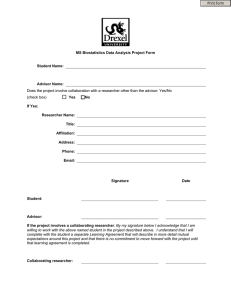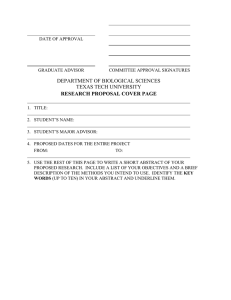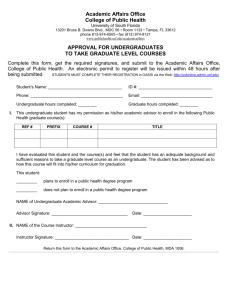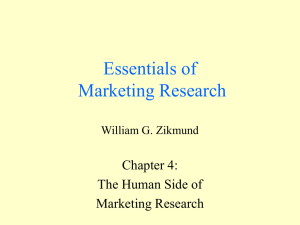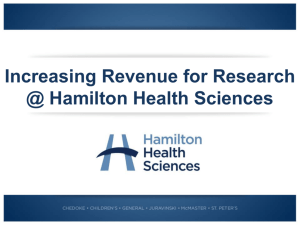Suggestions for Teaching the Engineering Research Process
advertisement
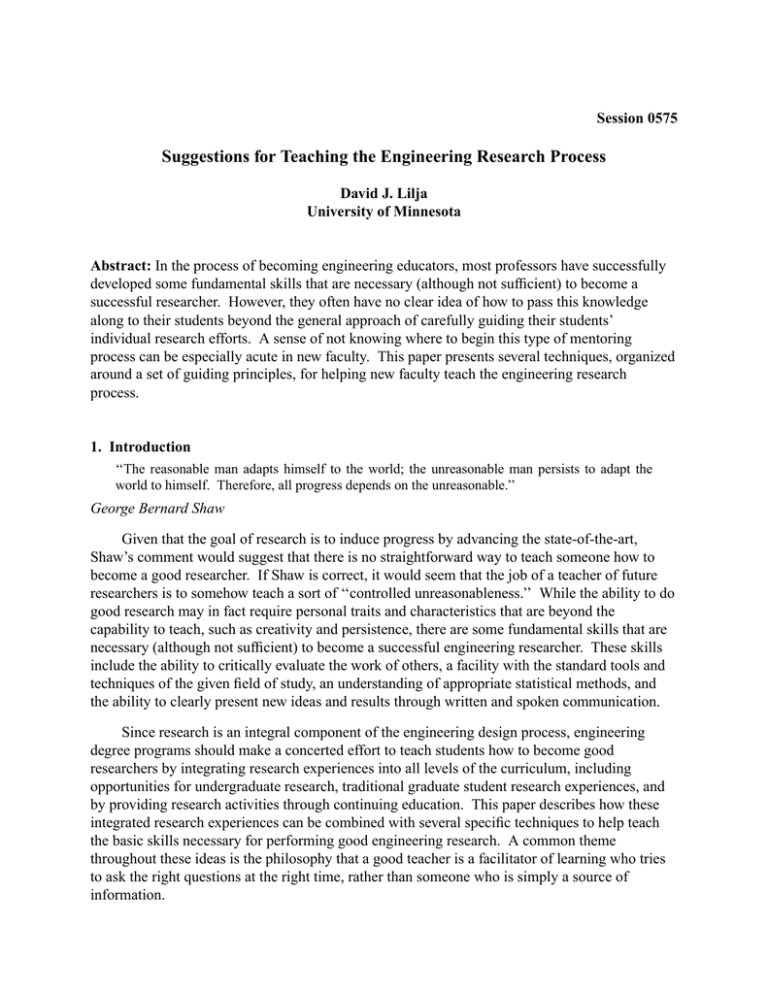
Session 0575 Suggestions for Teaching the Engineering Research Process David J. Lilja University of Minnesota Abstract: In the process of becoming engineering educators, most professors have successfully developed some fundamental skills that are necessary (although not sufficient) to become a successful researcher. However, they often have no clear idea of how to pass this knowledge along to their students beyond the general approach of carefully guiding their students’ individual research efforts. A sense of not knowing where to begin this type of mentoring process can be especially acute in new faculty. This paper presents several techniques, organized around a set of guiding principles, for helping new faculty teach the engineering research process. 1. Introduction ‘‘The reasonable man adapts himself to the world; the unreasonable man persists to adapt the world to himself. Therefore, all progress depends on the unreasonable.’’ George Bernard Shaw Given that the goal of research is to induce progress by advancing the state-of-the-art, Shaw’s comment would suggest that there is no straightforward way to teach someone how to become a good researcher. If Shaw is correct, it would seem that the job of a teacher of future researchers is to somehow teach a sort of ‘‘controlled unreasonableness.’’ While the ability to do good research may in fact require personal traits and characteristics that are beyond the capability to teach, such as creativity and persistence, there are some fundamental skills that are necessary (although not sufficient) to become a successful engineering researcher. These skills include the ability to critically evaluate the work of others, a facility with the standard tools and techniques of the given field of study, an understanding of appropriate statistical methods, and the ability to clearly present new ideas and results through written and spoken communication. Since research is an integral component of the engineering design process, engineering degree programs should make a concerted effort to teach students how to become good researchers by integrating research experiences into all levels of the curriculum, including opportunities for undergraduate research, traditional graduate student research experiences, and by providing research activities through continuing education. This paper describes how these integrated research experiences can be combined with several specific techniques to help teach the basic skills necessary for performing good engineering research. A common theme throughout these ideas is the philosophy that a good teacher is a facilitator of learning who tries to ask the right questions at the right time, rather than someone who is simply a source of information. 2. Principles for Doing Good Research One way of looking at the problem of trying to teach someone how to become a good researcher is to think in terms of trying to instill in them a set of rules or principles that they can use to guide their work. All good researchers use, whether consciously or not, something akin to the following set of principles throughout their careers. Principle 1: Don’t believe everything you read. ‘‘If I had thought about it, I wouldn’t have done the experiment. The literature was full of examples that said you can’t do this.’’ Spencer Silver on the work that led to the unique adhesives for 3M ‘‘Post-It’’ Notepads. One of the most important skills a good researcher can develop is the ability to find out what has been done before so as not to waste time duplicating previous work. This background development typically is done through library research, by keeping up-to-date with current publications, and by attending conferences and seminars to exchange ideas and visit informally with colleagues. One of the most difficult aspects of developing this skill, however, is learning to critically evaluate this previous work. It is of little value to know what has been done before if the researcher cannot evaluate the quality or the importance of the work. Furthermore, any researcher who wishes to publish their work will eventually be asked to review others’ submissions. Thus, it is essential to be able to critically evaluate others’ work. But how can this ability be taught? One approach that is particularly effective is to ask students to review papers assigned from the literature. These papers must be carefully selected both to teach up-to-date information about the topic of the course, as well as to provide examples of both good and not-so-good work. For each paper, or for a small group of papers that may all discuss a related point, students are asked to write a short (1-2 page) summary that addresses each of the following points [1]: 1. 2. 3. 4. 5. 6. 7. 8. What is the problem being studied? Is this an important problem? Why or why not? What are the main results? What method is used to produce the results? What are the assumptions in the paper? How realistic are they? How sensitive are the results to the assumptions? What did you learn from this paper? Describe the similarities and differences of this paper compared to other related papers. A grading system using a simple plus, check, or minus for these reports is often best since the point is to encourage the students to think deeply about the papers rather than to have the teacher spend a great deal of time grading them [2]. Another technique that is quite useful is to give the students an opportunity to practice the anonymous refereeing process with their peers. This technique works particularly well in a course that has a term project with a written report due at the end. Students are asked to turn in three copies of their report, but to leave their name off two of the copies. These two copies are then distributed to two randomly selected students in the class who are asked to read and grade the paper using the same criteria that the teacher will use. Note that the anonymous aspect of the process is necessary to ensure the privacy of the students being graded, and of the graders themselves, since all of the reviews should be returned to the authors. Grading their peers’ papers in this fashion allows the students to further develop their skills as referees, and it provides them with an opportunity to compare their own work with the rest of the class. Additionally, the extra insights provided to the teacher by the students’ reviews more than outweigh the small additional effort required to implement this process. This process is more problematic when dealing with students who take courses remotely, through an interactive television system, for instance, but using electronic mail to distribute and collect both the papers and the reviews effectively eliminates distance as a barrier. Principle 2: Know your tools. ‘‘If the only tool you have is a hammer, every problem begins to look like a nail.’’ Unknown Engineers working in all disciplines are faced with an often bewildering variety of tools with which to perform their research. These tools include the ubiquitous computer, as well as discipline-specific devices and procedures. While the proper use of mathematical and analytical methods are typically taught throughout the engineering curriculum, learning to use specialized research tools, such as electron microscopes or large multiprocessor high-performance computer systems, is often left for new researchers to learn on their own. This self-teaching process is not very efficient, however. One approach that can accelerate the learning process is to pair new students with students who are more experienced in using the needed tools. A useful byproduct of this pairing is that the more experienced student often learns more about the tool by answering the new student’s questions than he or she would learn simply by using the tool in their own research. It also is important to help the new student learn to choose the appropriate tool for the task at hand. For instance, researchers must develop the ability to determine when to use analytical modeling, computer simulation, or direct measurements. Furthermore, since engineers typically deal with real objects and practical ideas, it is important for these researchers to understand that all of their interactions with these objects are subject to experimental errors. These errors may be large, or they may be insignificant, but, in any case, it is important for the researcher to understand the causes and results of both systematic and random errors. As a result, it is vital for every engineer to understand the meaning of the terms accuracy, precision, and resolution when applied to their tools and resulting measurements. Additionally, they should understand how to use the statistical techniques applicable to their field to correctly express and communicate metrics of central tendency and variability, and to compare competing alternatives. It is impossible to judge the quality of engineering research results without the correct application of these basic mathematical skills. Principle 3: Practice, practice, practice. ‘‘A lecture is the process of transferring information from the notes of the instructor to the notes of the student without going through the mind of either.’’ Anonymous Research is a skill that can be learned only by doing. A book can describe a promising new methodology or research instrument, for instance, but the skill necessary to determine the right questions to ask in the first place requires an intuition and sense of judgement that can be developed only through practice. Unfortunately, typical forms of practice, such as homework assignments and laboratories associated with classes, are often artificial and limited in scope. As a result, students often find them dull and uninspiring. While students may develop useful background information and skills through these traditional approaches, they are seldom motivated to go beyond the basics. To obtain a deep understanding and appreciation for a subject and its traditions, there is no substitute for actual hands-on experience. One technique engineering educators can use to encourage this hands-on experience is to provide numerous opportunities for students to practice their budding research skills by integrating research experiences into all levels of the curriculum. Engineering programs have typically done an excellent job of providing hands-on practice of the research process at the graduate level through M.S. and Ph.D. ‘‘apprenticeships’’ that ultimately lead to a thesis. However, limiting research opportunities to graduate students completely ignores the potential of the undergraduate students who are, after all, the future graduate research assistants. Providing opportunities for undergraduate students to participate in ongoing research projects can produce significant benefits for both the students and the research advisor. For instance, many universities provide structured programs that require an undergraduate student to develop a proposal to work on a specific project with a specific faculty member [3]. While these programs often provide a stipend to the students, one of the primary motivating factors for many students is the opportunity to develop a deeper understanding of a subject that is of particular interest to them. One student involved in this type of program at the University of Minnesota reported: ‘‘I learned more in one quarter than I have in any class I have taken. In my opinion there is just no beating hands-on experience’’ [3]. Additionally, the experience of writing a research proposal, competing with other students for a limited number of positions, and learning to handle unexpected research problems provides them with practical skills that will enhance their future employment prospects. The close interaction with a faculty member that this type of research experience provides students helps them to begin establishing contacts in their field of interest, and it connects them with a mentor who can provide career and educational advice. Finally, it allows students to test whether they are capable of performing research, and whether they would enjoy a research career, without a making a substantial commitment of time or money. Undergraduate research is helpful not only to the student, but also to the teacher. One obvious benefit to a faculty advisor is that, through this type of undergraduate research experience, he or she obtains the help of an intelligent, enthusiastic worker who can often make substantial contributions to the research project. In addition, these research experiences give the faculty advisor a unique opportunity to provide the student with educational experiences that are simply unavailable or impractical to provide in a classroom environment. For example, through this learning-by-doing experience, students develop an appreciation and understanding of how new knowledge is discovered, and how new ideas and inventions are actually developed. As one faculty advisor involved in this type of program said, ‘‘[It] allows undergraduate students the opportunity to understand the true nature of knowledge-gaining’’ [3]. Finally, these experiences provide an ideal environment for advisors to evaluate potential new graduate students with little risk and no long-term commitment. In summary, these undergraduate research opportunities provide substantial tangible, and intangible, benefits for both the faculty advisor and the students. Principle 4: Inspiration requires perspiration. ‘‘Even if you are on the right track, you’ll get run over if you just sit there.’’ Will Rogers ‘‘It is not simply how busy you are, but why you are busy. The bee is praised; the mosquito is swatted.’’ Marie O’Conner Oftentimes, one of the most difficult aspects of graduate students’ experience is the feeling of being lost and without direction. They typically have a vague sense that they need to produce something novel to make a significant contribution, but they have no idea where to start. One technique to move them off of dead center and help them begin to feel that they have some direction is to assign them a task or project relevant to their area of interest with a specific goal. Working on this task can help them develop an intuitive feel for their subject which can increase their confidence and their motivation. Even if the task does not lead directly to a thesis or a paper, doing this work helps them feel that they are making progress. This experience forces them to confront the deficiencies in the current state-of-the-art, which can often lead to interesting research topics. Of course, it is important that students continue to read about their general area of research, but it can be more productive to also give them a concrete task. It is important, however, that both the advisor and the students avoid confusing simple activity with progress towards a goal. Students at all stages of their academic careers can feel isolated and unsure of their ability to make progress. Beyond the need to have a specific assigned task on which to work, holding regular group meetings with one’s students can help them to develop a sense of belonging, can develop good team-work among the group members, and can encourage peer-to-peer teaching. A useful focus for these meetings is to discuss current papers in the group’s research area. A nice byproduct of this group-building is that it frequently can remove a significant load from the research advisor by filtering out the routine questions of the newcomers. An equally important part of this group process is the advisor’s acknowledgement of the frustrations inherent in the research process, and his or her encouragement that the students also pursue some fun and relaxation. Principle 5: Don’t forget to think. ‘‘We haven’t much money so we must use our brains.’’ Lord Rutherford, Cavendish Laboratory With greater reliance on automation in the research process, it is all too easy for researchers to take machine-derived results at face value. However, all researchers have no doubt experienced the garbage-in, garbage-out phenomenon at one time or another. In detecting potentially faulty results, experienced engineering researchers often rely on their intuition and technical judgement. Consequently, it is important to instill in students a respect for the importance of this engineering judgement and to help them to develop their own intuition. While developing this type of intuition typically requires years of experience, there are some simple techniques that can be used to encourage its development in new researchers. One technique that helps develop good engineering judgement is to ask students to perform a simple ‘‘back-of-the-envelope’’ estimate of the expected results for all of their experiments. This estimate helps them develop a feel for whether a result makes sense. Soon they begin to perform this estimation automatically and quickly develop their own intuition for determining whether their results are at least of the right order of magnitude. Another technique that is important for all research practice is to verify results using two different methodologies. For instance, the results of a computer simulation should be verified by comparing the simulation results to measurements made on an existing system, or by comparing the results to a (perhaps lower fidelity) analytical model. It also is helpful to work with students to critically evaluate both good and bad designs to help them develop an understanding of what makes some approaches more fruitful than others. Finally, and perhaps somewhat paradoxically, it is important to encourage failure. Little of lasting value is ever achieved without taking risks, but risk invites failure. It is critical for new researchers to learn that no one is right all of the time and that without the risk of failure, there is little chance for important success. Researchers often can learn more from a failure than from a success by analyzing the cause of the failure rather than by reveling in a success. It also is important that students have the experience of failure while they are still in an environment that is supportive of this failure and that helps them learn that one of the keys to the research process is simple perseverance. Note, however, that failure is a particularly difficult lesson to learn for the group of individuals who are attracted to research since they typically have been quite successful in their lives and often have had little direct experience with failure. Principle 6: Don’t rush to judgement. ‘‘The concept is interesting and well-formed, but in order to earn better than a ‘C,’ the idea must be feasible.’’ A Yale University management professor in response to Fred Smith’s paper proposing reliable overnight delivery service. Smith went on to found Federal Express Corp. Fred Smith’s experience in developing the concept of overnight delivery begs the question, ‘‘What is an expert?’’ It is all too easy for the experienced researcher to think that he or she can quickly separate the good ideas from the bad, but, as has been demonstrated numerous times, an idea that may seem completely infeasible today may, with the proper champion, actually turn out to be very successful. It is important for both the researcher, and the teacher of the researcher, to recognize that students often know more about a specific subject than the ostensibly more experienced teacher. All researchers, both experienced and inexperienced, must learn to respect diversity since there are many different, equally valid ways to look at the same problem. Similarly, encouraging diverse modes of learning and thinking, such as intuition, experimentation, working on apparent tangents, and even day-dreaming, can lead to innovative solutions and ideas that could not have been developed through linear thought processes. 3. Conclusions Engineering research is a chaotic, nonlinear, unreasonable process that requires creativity, persistence, and the ability to innovate. Everyone is born with varying degrees of these necessary characteristics, but it is possible to encourage and further develop these characteristics in new researchers by: 1. Helping them learn to critically evaluate others’ work. Don’t believe everything you read. 2. Teaching them the fundamental measurement tools and techniques of their field. Know your tools. 3. Providing many opportunities to do real research. Practice, practice, practice. 4. Encouraging focused activity relevant to their field of research. Inspiration requires perspiration. 5. Instilling in them a good sense of engineering judgement. Don’t forget to think. 6. Respecting and encouraging all forms of diversity. Don’t rush to judgement. Perhaps articulating these principles will help engineering faculty do a more efficient job of teaching them to their students. Acknowledgements The ideas presented here are based on a talk I first presented at the Second Annual Workshop on Computer Architecture Education held February 3, 1996, in San Jose, California. I would particularly like to thank David Kaeli for inviting me to participate in that workshop since it forced me to recognize and organize my thoughts about teaching the research process. The research on which I have practiced these techniques and principles has been supported by the National Science Foundation, the Advanced Research Projects Agency, Cray Research, Inc., Computing Devices International, IBM, the Minnesota Supercomputer Institute, and the Graduate School of the University of Minnesota. References 1. Alan Jay Smith, ‘‘The Task of the Referee,’’ IEEE Computer, April 1990, pp. 65-71. 2. Barbara Gross Davis, Tools for Teaching, Jossey-Bass Publishers, San Francisco, 1993. 3. ‘‘Undergraduate Research Opportunities Program,’’ University of Minnesota Research Review, Office of Research and Technology Transfer, September 1996, pp. 15-19. DAVID J. LILJA is an Associate Professor of Electrical Engineering, and the Director of Graduate Studies in Computer Engineering, at the University of Minnesota in Minneapolis. His main research interests are in computer architecture, parallel processing, and high-performance computing. He is a Senior member of the IEEE, a member of the ACM, and is a registered Professional Engineer.
